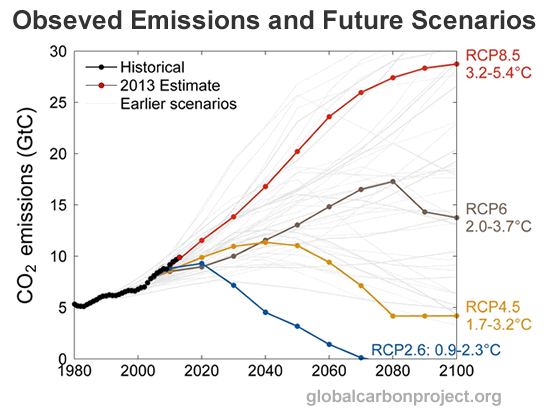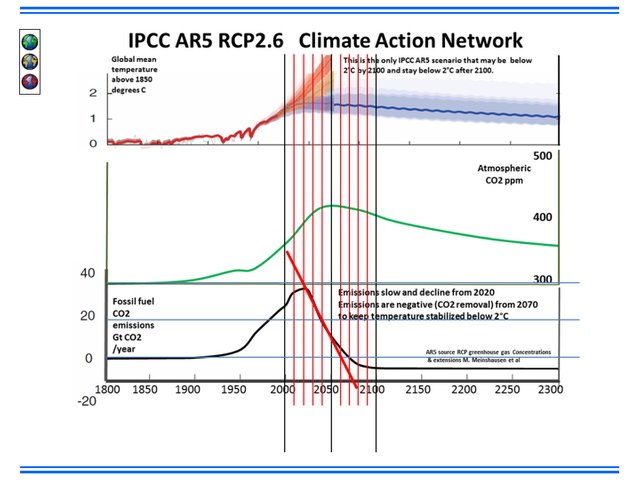Paris Climate Change Projections for a liveable world are based on Science Fiction
IPCC ‘Representative Concentration Pathways’ are based on fantasy technology, concealing a very bleak trajectory for humanity. Is this why policymakers are getting it so wrong?
Representative Concentration Pathways (RCP’s)
The Intergovernmental Panel on Climate Change published in their latest report, AR5, a set of ‘Representative Concentration Pathways’ (RCP’s). These RCP’s consist of four scenarios that project global temperature rises based on different quantities of greenhouse gas concentrations.
The scenarios are assumed to all be linked directly to emissions scenarios. The more carbon we emit then the hotter it gets. Currently humanity is on the worst case scenario of RCP 8.5 which takes us to 2°C warming by mid century and 4°C warming by the end of the century. As Professor Schellnhuber, from Potsdam Institute for Climate Research (PIK) said, “the difference between two and four degrees is human civilisation”.
In 2009 the International Union of Forest Research Organisations delivered a report to the UN that stated that the natural carbon sink of trees could be lost at a 2.5°C temperature increase. The ranges for RCP 4.5 and RCP 6 both take us over 2.5°C and any idea that we can survive when the tree sink flips from being a carbon sink to a carbon source is delusional.
Where does this leave us?
Of the four shown RCP’s only one keeps us within the range that climate scientists regard as survivable. This is RCP 2.6 that has a projected temperature range of 0.9°C and 2.3°C. Considering we are currently at 0.85°C above the preindustrial level of greenhouse gas concentrations, we are already entering the range and as Professor Martin Rees says, “I honestly would bet, sad though it is, that the annual CO2 emissions are going to rise year by year for at least the next 20 years and that will build up accumulative levels close to 500 parts per million”. The recent US/China ‘agreement supports the contentions of Rees.
Even if Rees is wrong and we do manage to curtail our carbon emissions, a closer look at RCP 2.6 shows something much more disturbing. In the attached image, IPCC SMP Expert Reviewer, David Tattershall has inserted vertical red lines to mark the decades between years 2000 and 2100. Within this 21st Century range he has also highlighted a steep decline in atmospheric concentrations of greenhouse gases (shown by the steep declining thick red line).
It is interesting that concerted action for emissions reductions is timed to occur just beyond the date for the implementation of a supposed legally binding international agreement.
Stopping emissions does not reduce atmospheric carbon. The emissions to date are colossal and the warming effect is delayed by around 40 years. Therefore, even if we halt emissions, we know there is much more warming to come. That will also set off other positive feedbacks along the way that will amplify the warming further, stretching over centuries.
So how does the IPCC achieve these vast reductions in greenhouse gases?
If we look at the vertical red lines, at around 2025 the steep decline in atmospheric greenhouse gases begins. Accumulated emissions not only are reduced to zero in 2070 but actually go negative. This chart shows that carbon is removed from the atmosphere in quantities of hundreds of billions of tonnes, for as far ahead as 2300 to sustain a temperature beneath 2°C.
What makes this idea of projected large-scale Carbon Dioxide Removal (CDR) even more perverse is the talk by policymakers of a “carbon budget”. This refers to the amount of fossil fuel that can be burned before we are at risk of reaching a 2°C rise in global mean temperature. It is quite clear that we have no carbon budget whatsoever. The account, far from being in surplus, is horrendously overdrawn. To claim we have a few decades of safely burning coal, oil and gas is an utter nonsense.
Sequestering billions of tonnes of carbon for centuries
If all of the above has not raised any alarm bells then perhaps it is time to consider the proposed methods for sucking the billions of tonnes of carbon out of the atmosphere.
In February 2015 the National Research Council in the United States launched their two reports on “climate interventions”. Dr Nutt concluded with this statement on CDR: “Carbon Dioxide Removal strategies offer the potential to decrease carbon dioxide concentrations in the atmosphere but they are limited right now by their slow response, by their inability to scale up and their high cost.”
Dr Nutt’s conclusion points to very important factor that we can elaborate on with a rare case of certainty. There is no proposed CDR technology that can be scaled up to suck billions of tonnes out of the Earth’s atmosphere. It simply does not exist in the real world.
This is reiterated by Dr Hugh Hunt in the Department of Engineering, at the University of Cambridge, who points out,
“10 billion tonnes a year of carbon sequestration? We don’t do anything on this planet on that scale. We don’t manufacture food on that scale, we don’t mine iron ore on that scale. We don’t even produce coal, oil or gas on that scale. Iron ore is below a billion tonnes a year! How are we going to create a technology, from scratch, a highly complicated technology, to the tune of 10 billion tonnes a year in the next 10 years?”
Science Fiction
It is not just that there are currently no ideas being researched to such a degree where they are likely to be able to bring down atmospheric carbon to a safe level of around 300 parts per million. It is also that the level of funding available to the scientists doing the research is woefully inadequate.
These RCP’s are used by policymakers to decide what actions are required to sustain a safe climate for our own and future generations. The information they are using, presented by the IPCC, is nothing more than science fiction. It makes for sober thinking when glossy images of President Obama and the Chinese Premier, Wen Jiabao, are presented to the world shaking hands on global emissions reductions by 2030 that we know will commit us to catastrophe.


Congratulations @nickgbreeze! You have completed some achievement on Steemit and have been rewarded with new badge(s) :
Click on any badge to view your own Board of Honor on SteemitBoard.
For more information about SteemitBoard, click here
If you no longer want to receive notifications, reply to this comment with the word
STOPHi! I am a robot. I just upvoted you! I found similar content that readers might be interested in:
http://www.theecologist.org/blogs_and_comments/commentators/2772427/survivable_ipcc_projections_are_based_on_science_fiction_the_reality_is_much_worse.html
increase in atmospheric CO2 is an effect of a temperature increase..not the cause. It follows by about a thousand years. The increase in atmospheric CO2 right now might be due to the Medieval warm period.
I am sorry but you are quite wrong. Every credible climate scientist in the world now agrees that the CO2 emitted by human civilisation is the cause of temperature rise. The reason you provide for the current increase has zero scientific credibility.
you didn't even look at the data I provided did you?
your logical fallacy for the day is appeal to authority
This is nonsense. Having conducted over 200 interviews in this field and studied "alt facts" (AKA climate disinformation), it is a solid policy to ignore "data" that is not supported by reputable scientists whose work is peer reviewed.
more appeal to authority. the charts I posted show the greenland ice cores and ACE..facts.